Van Gogh Museum Journal 1995
(1995)– [tijdschrift] Van Gogh Museum Journal–
[pagina 134]
| |
 fig. 1
Felician von Myrbach, The print shop, 1884, oil on canvas, 65 × 81 cm, Amsterdam, Van Gogh Museum | |
[pagina 135]
| |
Felician Freiherr von Myrbach: painter, illustrator, reformer
| |
Training and early careerFelician Myrbach was born in Zaleszczyki, in the Austrian region of Galicia, in 1853. He was a scion of an aristocratic family of military men, and in preparation for his career as an officer he was sent to Hainburg's cadet school at the age of eleven. The young man was soon recognised for his skill in draughtsmanship, and when he went on to the Vienna military academy, his art master warmly encouraged his talents. Felician was allocated a space of his own in his teacher's studio. Punishment in the form of detention was a great delight to the fledgling artist, who used such confinement to draw and paint to his heart's content. His classmates derisively nicknamed him ‘Schmyrbach’ (roughly meaning ‘dauber’). ‘It was from this time on,’ Myrbach later recalled, ‘that I truly felt a passion for art.’Ga naar voetnoot2 In 1872 he became a draughtsman at the institute of military geography, where he learnt the various graphic techniques used in the making of topographical maps. At the same time, this position gave him the opportunity to attend August Eisenmenger's classes in painting and life drawing at Vienna's art academy. Myrbach managed to continue his artistic activities when he was called to serve as an officer in Dalmatia three years later. He equipped a small room there as a studio, and had his companions pose for him in the evenings; during the day, he made numerous studies of the unique, colourful landscape. He was obliged to give up these sessions in 1878, however, when he was commissioned as a lieutenant for the occupation of Bosnia. But immediately upon his return to Vienna in October of 1879 he signed up for Eisenmenger's classes again in order to increase his skill in drawing human figures. He also took lessons in animal painting from Rudolf Carl Huber, as it gave him the opportunity to make a thorough study of horses for incorporation into his history paintings. During the Bosnian campaign Myrbach had made numerous studies and sketches, which he later composed | |
[pagina 136]
| |
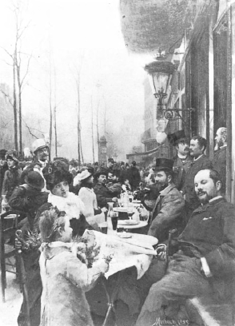 fig. 2
Felician von Myrbach, Au Boulevard Saint-Michel, 1883, oil on canvas, dimensions unknown, whereabouts unknown (photograph courtesy of the Österreichische Galerie, Vienna) into a painting of horizontal format entitled The 19th riflemen's battalion in the Battle of Kremenac (whereabouts unknown). He showed it in 1880 at the annual Künstlerhaus exhibition in Vienna, where it was immediately approved by the Emperor Franz Josef, who purchased it for his villa in Bad IschlGa naar voetnoot3 for the sum of 2,000 Austrian guilders.Ga naar voetnoot4 Although he was still a student at the academy, this success prompted his selection for membership in the Künstlerhaus. Huber, however, had some blunt words of advice: ‘Vienna has nothing more to teach you - go to Paris.’Ga naar voetnoot5 Many Austrian artists viewed Paris, like Munich, as a necessary step in their artistic career. Myrbach's decision to follow this recommendation did mean, of course, that he had to bid farewell to the army, and in 1881 he handed in his resignation. In November of that year he moved to Paris, where he was to remain for sixteen years. In his memoirs Myrbach jested that he had originally planned to stay for no more than a year, but lacking money for the return journey he had decided to stay longer.Ga naar voetnoot6 | |
Early years in ParisIn the Montparnasse neighbourhood so beloved by artists he found a spacious studio that was fitted with the unusually modern convenience of electric lighting. Nearby he attended evening classes in life painting taught by the famous portrait painter Carolus-Duran, who attracted a | |
[pagina 137]
| |
 fig. 3
Felician von Myrbach, Au Boulevard Saint-Michel, 1883, pen and ink, dimensions unknown, whereabouts unknown, from Annuaire illustré des beaux-arts, 1883, p. 176 steady flow of students to his large studio on Boulevard Montparnasse. Besides paintings and life drawings, Myrbach produced numerous studies, watercolours and drawings of Paris scenes.Ga naar voetnoot7 In 1882, Myrbach made his first submission to the Salon: Rebel outpost in Herzegovina (whereabouts unknown),Ga naar voetnoot8 another theme inspired by his former life as an officer. But his first real success came one year later, when his painting Au Boulevard Saint-Michel (whereabouts unknown) was exhibited at the Salon (fig. 2).Ga naar voetnoot9 The painting presents an engaging picture of a Paris terrace on the famous boulevard, with several well-known personalities from the Latin Quarter dominating the foreground. Unlike the seemingly uncomposed work of the renowned boulevard painter Jean Béraud, Myrbach's painting has a striking, compact composition, with heightened perspectival effects. The set of little tables moving towards the centre of the painting, together with the line leading over the tops of the bare trees and that following the façades on the right, create two intersecting diagonal axes. The lower edge that cuts off the little flower-girl and the right corner slicing through the reclining man are devices which draw the viewer into the picture. In this way, the many realistic details and the crowd of people all merge into a single cohesive entity.Ga naar voetnoot10 A drawing by Myrbach himselfGa naar voetnoot11 after this work was used for a plate in the Annuaire illustré des beaux-arts (fig. 3),Ga naar voetnoot12 | |
[pagina 138]
| |
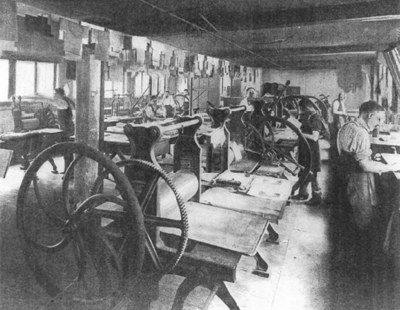 fig. 4
Workshop with etching-presses, Wittmann's print shop, from Marius Vachon, Les arts et les industries du papier, 1894, p. 63 and it seems likely that the artist's subsequent popularity was in many ways a result of the spread of this successful image through reproduction. It seems that Myrbach's work struck a chord with the Paris public, and commissions for book and magazine illustrations suddenly poured in, leaving him little time to paint. It is for this reason that works on canvas by Myrbach after 1883 are so rare; in fact, The print shop (fig. 1) is the only known masterpiece from the Paris period. Judging by the quality of this work, we have reason to regret the flood of assignments for book illustrations that kept Myrbach from his easel. The print shop was shown at the Salon of 1884 and reproduced in the catalogue.Ga naar voetnoot13 The painting shows six printing-presses side by side. The presses are arranged along a diagonal, their handles in a variety of positions, thus providing optical movement in the left half of the painting. The right half, in contrast, is far more restful in composition. The straight lines of the suspended sheets of paper and the cupboard provide a counterpoint to the composition on the left. Myrbach has remained faithful to the drabness of the print shop, introducing only a very few colour accents in details such as the lamp, the blue and white overall and the paint-pots on the shelf on the left. The workers portrayed are engaged in various stages in the printing process. On the right, a man is removing excess ink from a plate, while a boy on the left is turning the handle of the press. At the centre of the composition, a master and pupil together scrutinise the quality of a printed illustration, probably a frontispiece. During the preparation of an etching, the plate and paper would be covered with felt to ensure the evenness of the print. In the painting we can clearly see the felt on the rollers and the plates of the first two presses. After the plate had passed through the press, the printed sheets would be hung up to dry on lines, as shown in the upper right of the painting. This painting most likely depicts one of the printing-presses that produced Myrbach's own illustrations, although its precise identification is no easy task. One of | |
[pagina 139]
| |
the possibilities is Quantin, one of Myrbach's first clients. Some of the drawings and watercolours commissioned were for children's books. The Albums series included several volumes illustrated by Myrbach: Gargantua, Don Quichote, Ali Baba ou les quarante voleurs and Le chat botté. However, these popular children's books did not appear with engravings. They had colour prints or chromotypes, and were printed on machines that were far larger and more modern than those depicted in Myrbach's painting.Ga naar voetnoot14 A photograph of the interior of Wittmann's printing-house (fig. 4) reveals a marked resemblance to the representation in Myrbach's painting, both in the arrangement of etching-presses and the methods employed there. The presses are set in a row in the studio, which has glass panels on the left and right to admit as much light as possible. Both in the photograph and in the painting, a man stands on the right, rubbing the ink off a plate. Near the ceiling are stretched wires on which the newly printed sheets of paper can hang to dry. The basic model of the etching press is also the same, except that Wittmann's presses are slightly more modern, having cogs instead of levers. Notwithstanding the resemblances between this photograph and the painting, however, there is no reference to Wittmann in relation to Myrbach's etchings or book illustrations. The identity of the printing-press shown in the painting The print shop must therefore remain, for the time being, a matter of conjecture. | |
SuccessIn the spring of 1886, Myrbach left his small apartment in the rue Campagne Première. He and his wife Lily moved into a house near the Bois de Clamart. A steady flow of commissions for illustrations ensured that money was never a problem. Myrbach's style was particularly suited to book illustrations, and his services were enlisted for numerous projects. He received orders from magazines such as Le Monde Illustré, Le Monde Pittoresque and Paris Illustré, as well as from literary publishers such as Lahure & Baschet, Quantin, and Hachette. There were several common types of book illustrations during the 1880s. Primary among them was the historicist style, the best known exponent of which was Ernest Meissonier. Besides depicting events in military history, Meissonier also produced neo-baroque and neo-rococo genre pieces. But his work was too erudite for publishers who wanted their books to appeal to the masses. Popular editions of historical novels by Victor Hugo and Alexandre Dumas, for instance, were generally illustrated by artists like Georges Rochegrosse, Charles Delort or Luc Olivier Merson, in an academic style that Söderberg has referred to in his study of French book illustration as ‘musketeer style.’Ga naar voetnoot15 Alongside this more traditional style, realism was also taking hold in French book illustration, and Myrbach benefitted from this. The picaresque and adventure novels of Alphonse Daudet, for instance, many of which were illustrated by the artist, were particularly well served by his narrative style.Ga naar voetnoot16 Myrbach's illustrations, however, have none of the innovative style of artists such as Raffaëlli, Legrand or Forain. Perusal of Myrbach's sketches and drawings allows us, up to a point, to reconstruct his working method. His sketchbook, once in the possession of Hans Ankwicz-Kleehoven and now in the library of Vienna's Museum für Angewandte Kunst, contains many first impressions - preliminary watercolours of his subjects dashed off in rapid, vigorous brushstrokes.Ga naar voetnoot17 One or more of these would then | |
[pagina 140]
| |
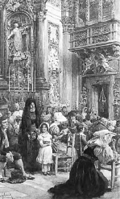 fig. 5
Felician von Myrbach, Study for Tolla, c. 1889, watercolour on paper, 25.9 × 15.8 cm, signed at lower left: Myrbach, Vienna, Graphische Sammlung Albertina (inv. no. 38352) be turned into detailed studies of the setting. The journal Kunst und Kunsthandwerk,Ga naar voetnoot18 for instance, includes an elaborate drawing of the interior of II Gesù in Rome, which served as the setting for one of his illustrations for Edmond About's Tolla,Ga naar voetnoot19 and the Albertina has a watercolour of the same interior with the figures added (fig. 5). This watercolour served in turn as the direct example for the engraver, Léon Rousseau, who translated it into a wood engraving, accompanied by the following lines of prose taken from the book: ‘Elle détacha vivement son petit bracelet de corail et le donna aux âmes du Purgatoire.’Ga naar voetnoot20 Whether he was recording scenes from everyday life, special events or places of historic interest, Myrbach 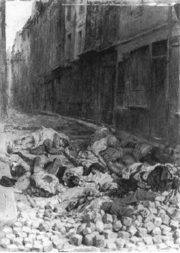 fig. 6
Ernest Meissonier, The barricade, 1849, oil on wood, 29 × 22 cm, Paris, Musée du Louvre always visited the relevant locale, registering his impressions in a host of preliminary studies and drawings. As we have seen, he went to Italy for Hachette in order to produce the watercolours for Tolla. For Daudet's Tartarin sur les Alpes he went to Switzerland, and he and his wife even went so far as to climb Mont Blanc, assisted by two guides.Ga naar voetnoot21 He likewise thought it entirely within the call of duty, when asked by the English publishing-house Virtue to create a series of traveller's impressions of England, to undertake an extensive journey from the north to the south of the country, executing each one of his impressions on the spot.Ga naar voetnoot22 The marked realism of Myrbach's depictions of fictional characters never degenerated into an overly | |
[pagina 141]
| |
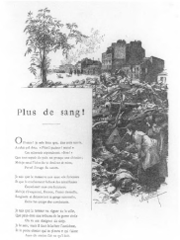 fig. 7
Felician von Myrbach, Plus de sangl, from François Coppée, Oeuvres complètes: poésies, 1888, p. 147 picturesque or academic style. His naturalism, in fact, approached photographic realism, yet constantly exhibited new discoveries and compositional tours de force.Ga naar voetnoot23 Myrbach tackled an enormous variety of subject-matter, from scenes of fashionable Parisian or Viennese life to minutely rendered interiors. His term as a lieutenant in the Austrian army, during which time he had experienced many campaigns at first hand, often brought him back to military themes. His soldiering had not stopped him from producing scores of studies on the battlefield, whose directness lent his military scenes a special air of authenticity. The Viennese critic Ludwig Hevesi greatly admired the verisimilitude of Myrbach's work; he claimed that even Meissonier's military themes were not more true to life.Ga naar voetnoot24 A closer examination, however, reveals this to be an exaggeration. Comparison of Myrbach with Ernest Meissonier, the famous French military history painter, reveals that Myrbach's military illustrations not only resemble paintings such as French campaign, 1814 (Paris, Musée d'Orsay) and Napoleon III at the Battle of Solférino (Compiègne, Musée du Château), but also recall the spontaneity and directness of Meissonier's smaller works, oil sketches and drawings. Meissonier's arresting Barricade (fig. 6), for instance, an indictment of the horrors of civil war, undoubtedly served as Myrbach's inspiration for his illustration to accompany Coppée's poem Plus de sang! (fig. 7).Ga naar voetnoot25 In both works, the foreground is entirely taken up by the ruins of a makeshift barricade strewn with corpses, and in both the painting and the drawing, the upper half consists of a row of houses crossing the pictorial surface diagonally. Barricade is clearly more powerful in both composition and execution, while Myrbach's pen and ink drawing remains largely illustrative. The chilling emptiness of the row of facades in Meissonier's painting is reduced to mere scenery in Myrbach, and Meissonier's restrained, unadorned style contrasts with Myrbach's irrepressible urge to add anecdotal details such as the two women in the foreground and the cavalry in the background. This said, Plus de sang! undoubtedly displays a finely balanced chiaroscuro. Nor must we forget that Myrbach's drawing has been translated here by an engraver, which may have diluted the spontaneity of the original pen and ink drawing. Not surprisingly, books with military themes occupied a good part of Myrbach's career as an illustrator: they include Unter den Fahnen: die Völker Österreichs-Ungarns in Waffen, Feldmarschall Erzherzog Albrecht, Aventures de guerre by Frédéric Masson and Paraquin's Souvenirs.Ga naar voetnoot26 His illustrations for these books fall into one of two categories: | |
[pagina 142]
| |
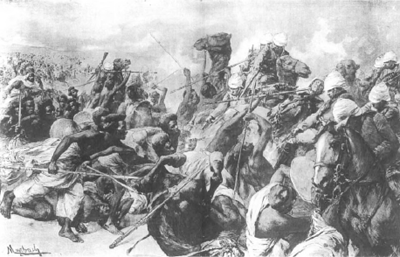 fig. 8
Felician von Myrbach, The Battle of Abou-Klea, from Paris Illustré, nos 28/29 (April 1885), pp 88-89 on the one hand there were rapidly executed black and white drawings in pen or ink wash, based on numerous sketches from life, and on the other - for relatively prestigious works such as the life of Archduke Albrecht - elaborate watercolours. The former were usually integrated into the text, while the latter were reproduced in a colour plate occupying a separate page. Often, facsimile prints after these illustrations were made. For instance, a poster announcing the forthcoming exhibition of Myrbach's work in Vienna in 1898 included an advertisement offering for sale 50 numbered and signed prints of Myrbach's watercolours of Archduke Albrecht and Archduke Karl.Ga naar voetnoot27 One of Myrbach's patrons was François-Guillaume Dumas, an art dealer as well as a publisher, writer and editor. He was responsible for a series entitled Artistes modernes for which Myrbach depicted the studios of both MeissonierGa naar voetnoot28 and Cabanel.Ga naar voetnoot29 Dumas also launched the journal Paris Illustré, to which he appointed Myrbach illustrator-in-chief. This job involved a great variety of subjects, providing a wealth of opportunities to try out new themes and compositions. | |
[pagina 143]
| |
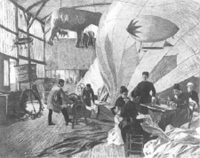 fig. 9
Felician von Myrbach, Air-balloon workshop in Paris (Vaugirard): construction and drying of a balloon, from Paris Illustré, no. 24 (1 January 1885), p. 8 The wash drawing The Battle of Abou-Klea, a complicated composition with camels and horses among Arabs and colonists enmeshed in a struggle to the death, was divided over two pages, which enhanced the numerous shades of grey (fig. 8).Ga naar voetnoot30 Here, as in Au Boulevard Saint-Michel, Myrbach preserves the balance of his picture with a composition based on two intersecting diagonals. Of equal interest is the engraving after Myrbach's Air-balloon workshop in Paris (Vaugirard): construction and drying of a balloon (fig. 9).Ga naar voetnoot31 One of Myrbach's most successful series of illustrations for the Paris Illustré was Les coulisses du Salon (1885), a behind-the-scenes look at the organisation and mounting of a Salon exhibition.Ga naar voetnoot32 The drawing on the title-page of the article (fig. 10) shows twelve workmen attaching a huge work (by the painter Rochegrosse) to the wall under the watchful eye of a supervisor and a jury member. Myrbach depicts the sad lot of those rejected from the Salon in his illustration aptly entitled Graveyard of the refusés, the original drawing for which is in The Metropolitan Museum of Art in New York (fig. 11).Ga naar voetnoot33 It is an extremely rhythmic composition, in many way similar to Myrbach's Salon paintings, with plunging, dramatic perspective. The rows of paintings stacked against each other produce an endless, almost unreal effect in a wavelike movement, reinforced by the  fig. 10
Felician von Myrbach, The hanging of the paintings, from Paris Illustré, no. 30 (1 May 1885), p. 98 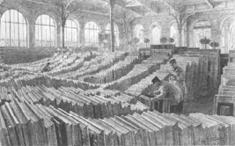 fig. 11
Felician von Myrbach, Graveyard of the refusés, grey pen and wash, pencil, on cloth, 33.5 × 49 cm, New York, The Metropolitan Museum of Art (Harris Brisbane Dick Fund, 47.53.19) | |
[pagina 144]
| |
 fig. 12
Felician von Myrbach, The arrangement of the paintings, from Paris Illustré, no. 30, (1 May 1885), p. 99 fact that we can see only their frames. A third drawing illustrates the arrangement of the canvases (fig. 12). Besides Tartarin sur les Alpes by Alphonse Daudet, Myrbach also illustrated such famous novels as Notre-Dame de Paris by Victor Hugo and Madame Chrysanthème by Pierre Loti (fig. 13).Ga naar voetnoot34 Some of his finest works in this genre were the drawings he made for the three-volume Oeuvres complètes of François Coppée (fig. 14).Ga naar voetnoot35 These writers were full of praise for Myrbach's talent. Alphonse Daudet once told Myrbach that he had boundless faith in him, as all his books illustrated by Myrbach had brought him success.Ga naar voetnoot36 | |
Myrbach as reformerAustria had not, however, forgotten Myrbach. Through the commission from Crown Prince Rudolf for Unter den Fahnen, Myrbach had once again come into contact with his native country. These high connections later also helped to assure him of a new, prestigious position. He left Paris and in 1897 he was appointed Professor at the Kunstgewerbeschule in Vienna, where he took charge of the ‘Fachklasse für Graphik,’ a department that largely concerned itself with illustrations, both drawings and prints. In May 1897 Myrbach, together with several other progressive artists, had left the Künstlerhaus and joined the Vereinigung bildender Künstler Österreichs, better known as the Secession. Between 1898 and 1905 - the duration of the original Secession group led by Gustav Klimt-Myrbach engaged in a variety of activities. We find his name not only in the Secession's exhibitions, but also in its administration, and he was elected President in 1903. It was in this capacity that he opened Gustav Klimt's Kollektivschau that year, and the memorable Hodler exhibition a year later. Myrbach's official duties obviously pushed his own artistic activities into the background. In the spring of 1898 Vienna's Artaria gallery organised the last major solo exhibition of his work during his lifetime. Some 58 works were shown, including many watercolours and drawings.Ga naar voetnoot37 The centrepiece of the exhibition was the large watercolour The Imperial parade at the Schmelz, which the Emperor purchased for his Imperial Gallery (fig. 15).Ga naar voetnoot38 | |
[pagina 145]
| |
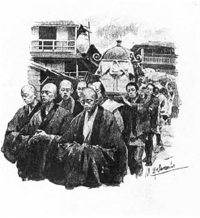 fig. 13
Felician von Myrbach, Funeral procession, from Pierre Loti, Madame Chrysanthème, 1888, p. 126 Among those to remark on the show was the discerning critic Adolf Loos, who reviewed it for Die Waage: ‘Myrbach has been particularly successful at Artaria & Co. on the Kohlmarkt. This accomplished painter has learned something new abroad [i.e. in Paris], while here he would only have grown stale and vulgar.’Ga naar voetnoot39 Loos continued with a warm commendation of Myrbach's honest art. He saw Myrbach as someone who faithfully reproduced everyday reality without steeping it in aestheticism: ‘Now here is someone who paints decent people just as they are. It is arresting. It is new to us. It makes us enjoy being out in the street.’Ga naar voetnoot40 In 1900, when Myrbach was appointed director of the Kunstgewerbeschule, he brought with him several fellow-artists 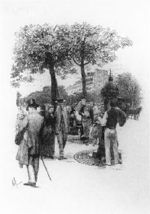 fig. 14
Felician von Myrbach, Paris, from François Coppée, Oeuvres complètes: poésies, 1888, p. 229 from the Secession and conducted a thorough reorganisation.Ga naar voetnoot41 ‘It was astonishing how cannily Myrbach was able to pluck from the ranks of the unknown those destined to become the foremost creative geniuses of the new art education.’Ga naar voetnoot42 He started by putting Josef Hoffmann in charge of the architecture class. Myrbach also appointed Alfred Roller, who was to revolutionise theatrical decor, and Kolo Moser, who injected new life into the decorative arts. By putting in place this team of personalities and art teachers, and by establishing workshops, Myrbach was able to raise the Vienna Kunstgewerbeschule to an eminence from which it towered over other institutes. Pupil numbers increased every year, with a substantial foreign contingent among them. | |
[pagina 146]
| |
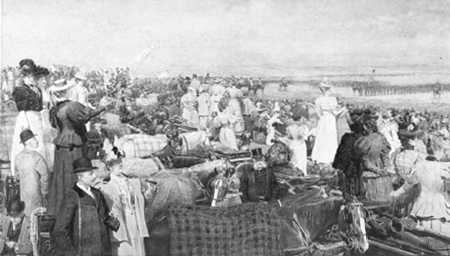 fig. 15
Felician von Myrbach, The Imperial parade at the Schmelz, 1898, watercolour on paper, 83 × 143.6 cm, signed lower right: Myrbach (1)898; verso in pencil: Myrbach-Ausstellung 1898, and a stamp: Kunsthandel Artaria, Vienna, Heeresgeschichtliches Museum One of the first things Myrbach did as director of the Kunstgewerbeschule was to consign the plaster casts to the attic. His pupils were to draw from life, including nudes, in order to develop a sound knowledge of anatomy. Myrbach also encouraged the preparation of a new version of the ancient collection of Specimens (Vorlagenwerke), files containing architectural details and designs that in the past had merely been slavishly copied. Together with Hoffmann and Moser, Myrbach published the quality journal Die Fläche,Ga naar voetnoot43 to which many artists contributed decorative designs for posters, tapestries or stained-glass windows. Most of the graphic designs were printed using aluminography, a process that Myrbach introduced into Austria (fig. 16). As director, he continually explored new ideas for his Kunstgewerbeschule. In the winter of 1902 he and Josef Hoffmann travelled to England and Scotland to study the courses on offer at places such as the Glasgow School of Art. British art education had a major impact on art schools in Vienna, not only at the Kunstgewerbeschule, but also at the Wiener Werkstätte, which was established in 1903 to give a new impulse to the applied arts. In Vienna, Myrbach was regarded as a successful painter and art teacher, and he was often asked to contribute to publications such as the Secession journal Ver Sacrum.Ga naar voetnoot44 The art world was buzzing with the success of Myrbach's innovations at the Kunstgewerbeschule. In 1900, during the Exposition Universelle in Paris, he wrote enthusiastically to his wife: ‘I am in buoyant mood, as Austria is enjoying a wonderful, unparalleled success here in the decorative arts section. It is said that everyone rates our work highest of all. I went early to see the school's stand; it looks excellent. Many people are eager to buy or to place orders. Sarah Bernhardt was absolutely captivated by it all.’Ga naar voetnoot45 | |
[pagina 147]
| |
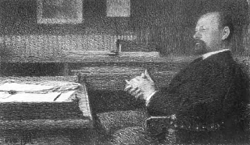 fig. 16
Felician von Myrbach, Portrait of Franz Ritter, 1899, aluminograph, 27.6 × 46.7 cm, signed on the plate at lower right: Mh 1899; signed in pencil at lower right: Myrbach, Vienna, Graphische Sammlung Albertina In 1904 Myrbach was put in charge of organising Austria's entries to the World's Fair in St Louis.Ga naar voetnoot46 Eager to record all the impressions of America as they crowded in on him in his sketchbook and notepad, he journeyed onward from St Louis to California. There he suffered an attack of rheumatism that prevented him from going on. He then asked the Ministry for permission to extend his stay in the United States. Due to a series of misunderstandings (Myrbach had stopped communicating with everyone) and intrigues stirred up and magnified by the press (he was said to have had an affair while abroad), the artist was reported to have mysteriously disappeared. This scandal was compounded by the fact that things went seriously wrong at the Kunstgewerbeschule during his absence. On his return, Myrbach was virtually forced into early retirement.Ga naar voetnoot47 His private life was likewise troubled. His marriage to Lily broke down, and since he no longer felt tied to Vienna he sold his house on the Praterstraße and sent his complete collection of sketches and drawings, numbering over 500 pieces, to be sold at the well-known Dorotheum auction-house.Ga naar voetnoot48 As a result, the work of this immensely productive artist - except for what had been preserved in the form of book illustrations - was dispersed in a thousand directions. Myrbach left Vienna in April 1905, and returned to Paris, where Frédéric Masson commissioned him to illustrate his 23-volume work on the life of Napoleon.Ga naar voetnoot49 Myrbach threw himself into this work with characteristic verve for over ten years, travelling to Corsica and Elba, to the battlefields of Aspern and Wagram, with the aim of reconstructing events as accurately as possible. In 1914, at the outbreak of the First World War, Myrbach risked being called up as an Austrian reserve officer, despite his age. Abandoning all his worldly possessions, he fled to Spain, where he settled in the Barcelona region. Here he produced scores of drawings and watercolours: ‘Every morning I go down to the beach to study. It has light, air and crowds of people with colours and glittering sunlight that are absolutely soul-stirring.’Ga naar voetnoot50 In the 1930s his peace was once again shattered as civil war became an ever-increasing threat and then a reality. As an Austrian baron he received threats from the Spartacists, and eventually was forced to return to Vienna. There he died in 1940, at the venerable age of 87. |
|

